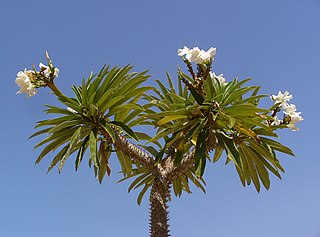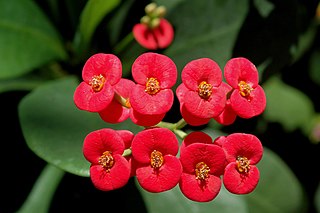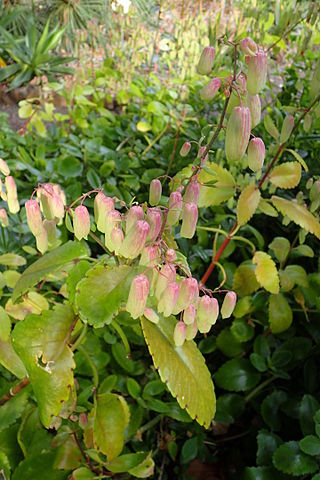
The Crassulaceae, also known as the stonecrop family or the orpine family, are a diverse family of dicotyledon flowering plants characterized by succulent leaves and a form of photosynthesis, known as Crassulacean acid metabolism (CAM). Flowers generally have five floral parts. Crassulaceae are usually herbaceous but there are some subshrubs, and relatively few treelike or aquatic plants. Crassulaceae are a medium-sized monophyletic family in the core eudicots, among the order Saxifragales, whose diversity has made infrafamilial classification very difficult. The family includes approximately 1,400 species and 34–35 genera, depending on the circumscription of the genus Sedum, and distributed over three subfamilies. Members of the Crassulaceae are found worldwide, but mostly in the Northern Hemisphere and southern Africa, typically in dry and/or cold areas where water may be scarce, although a few are aquatic.

Pachypodium lamerei is a species of flowering plant in the family Apocynaceae. It is a stem succulent, photosynthesizing mainly through its trunk, and comes from the island of Madagascar, off the east coast of Africa. It has large thorns and leaves mostly just at the top of the plant, and large, fragrant flowers. The species has become one of the best known pachypodiums in cultivation, being relatively easy to propagate and grow. In cultivation it is often marketed as the Madagascar palm, despite its not being a palm at all. A variety called "Ramosum" has been described. It is distinguished mostly by a dwarf growth habit and its more rounded corolla lobe.

Alstroemeria, commonly called the Peruvian lily or lily of the Incas, is a genus of flowering plants in the family Alstroemeriaceae. They are all native to South America, although some have become naturalized in the United States, Mexico, Australia, New Zealand, Madeira and the Canary Islands. Almost all of the species are restricted to one of two distinct centers of diversity: one in central Chile and southern Argentina, the other in eastern Brazil. Species of Alstroemeria from Patagonia are winter-growing plants, while those of Brazil are summer growing. All are long-lived perennials except A. graminea, a diminutive annual from the Atacama Desert of Chile.

Kalanchoe, , is a genus of about 125 species of tropical, succulent plants in the stonecrop family Crassulaceae, mainly native to Madagascar and tropical Africa. A Kalanchoe species was one of the first plants to be sent into space, sent on a resupply to the Soviet Salyut 1 space station in 1979. The majority of kalanchoes require around 6–8 hours of sunlight a day; a few cannot tolerate this, and survive with bright, indirect sunlight to bright shade.

A houseplant, sometimes known as a pot plant, potted plant, or an indoor plant, is an ornamental plant that is grown indoors. As such, they are found in places like residences and offices, mainly for decorative purposes. Common houseplants are usually tropical or semi-tropical, and are often epiphytes, succulents or cacti.

Impatiens walleriana, also known as busy Lizzie, balsam, sultana, or simply impatiens, is a species of the genus Impatiens, native to eastern Africa from Kenya to Mozambique. The Latin specific epithet walleriana honours a British missionary, Horace Waller (1833–1896).

Hyacinthus orientalis, the common hyacinth, garden hyacinth or Dutch hyacinth, is a species of flowering plant in the family Asparagaceae, subfamily Scilloideae, native to southwestern Asia, southern and central Turkey, northwestern Syria, Lebanon and northern Palestine. It was introduced to Europe in the 16th century. It is widely cultivated everywhere in the temperate world for its strongly fragrant flowers which appear exceptionally early in the season, and frequently forced to flower at Christmas time.

Kalanchoe beharensis is a plant species in the succulent genus Kalanchoe, and the family Crassulaceae. Kalanchoe beharensis is native to Madagascar known by local names mongy, rongy and tavitavy.

Ilex aquifolium, the holly, common holly, English holly, European holly, or occasionally Christmas holly, is a species of flowering plant in the family Aquifoliaceae, native to western and southern Europe, northwest Africa, and southwest Asia. It is regarded as the type species of the genus Ilex, which by association is also called "holly". It is an evergreen tree or shrub found, for example, in shady areas of forests of oak and in beech hedges. In the British Isles it is one of very few native hardwood evergreen trees. It has a great capacity to adapt to different conditions and is a pioneer species that repopulates the margins of forests or clearcuts.

Bryophyllum is a group of plant species of the family Crassulaceae native to Madagascar. It is a section or subgenus within the genus Kalanchoe, and was formerly placed at the level of genus. This section is notable for vegetatively growing small plantlets on the fringes of the leaves; these eventually drop off and root. These plantlets arise from mitosis of meristematic-type tissue in notches in the leaves.

Euphorbia milii, the crown of thorns, Christ plant, or Christ's thorn, is a species of flowering plant in the spurge family Euphorbiaceae, native to Madagascar. The species name commemorates Baron Milius, once Governor of Réunion, who introduced the species to France in 1821.

Kalanchoe thyrsiflora is a species of flowering plant native to Botswana, Lesotho, South Africa and Eswatini. This plant is rare in cultivation, and those plants labelled as "Kalanchoe thyrsiflora" in horticulture are mostly another similar species, Kalanchoe luciae.

Kalanchoe delagoensis, formerly known as Bryophyllum delagoense and commonly called mother of millions or chandelier plant, is a succulent plant native to Madagascar. Like other members of Bryophyllum, it is able to propagate vegetatively from plantlets that develop on its leaf margins.

Kalanchoe pinnata, commonly known as cathedral bells, air plant, life plant, miracle leaf, Goethe plant, and love bush, is a succulent plant native to Madagascar. It is a popular houseplant and has become naturalized in tropical and subtropical areas. The species is distinctive for the profusion of miniature plantlets that form on the margins of its leaves, a trait it has in common with some other members of Bryophyllum.

Kalanchoe rhombopilosa is a succulent plant species in the family Crassulaceae. This species of plant is endemic to southwest Itampolo, Madagascar. The species was described by Mannoni & Boiteau in 1947 and is indexed in Notul. Syst. (Paris) 13:153-154, (1947). The plant is a herbaceous perennial that grows to 10–20 cm in height.

Oscularia deltoides, the deltoid-leaved dewplant, dassievygie or sandsteenvygie is a species of flowering succulent plant in the fig-marigold family Aizoaceae that is native to the south-western Cape, South Africa.

Kalanchoe manginii, beach bells, is a species of flowering plant in the family Crassulaceae, native to Madagascar.

Kalanchoe marmorata, the penwiper, is a species of flowering plant in the family Crassulaceae, native to Central and East Africa, from Zaire to Ethiopia, Sudan and Somalia. It is an erect or decumbent succulent perennial growing to 40 cm (16 in) tall and wide, with glaucous leaves spotted with purple, and starry white, four-petalled flowers, sometimes tinged with pink, in spring. As the minimum temperature for cultivation is 12 °C (54 °F), in temperate regions it is grown under glass as a houseplant.

Kalanchoe pumila, the flower dust plant, is a species of flowering plant in the stonecrop family Crassulaceae, native to Madagascar. The Latin specific epithet pumila means dwarf or low-growing.

Kalanchoe × poincarei is a species of Kalanchoe native to southern Madagascar. Its scientific name is often misapplied to K. suarezensis and K. mortagei, but K. × poincarei is very different from them. The true K. × poincarei is a natural hybrid involving K. beauverdii, with similar sprawling stems up to 3 m in length, and not known in cultivation, whereas K. suarezensis and K. mortagei are erect, 30~60 cm tall and cultivated as ornamentals.


























